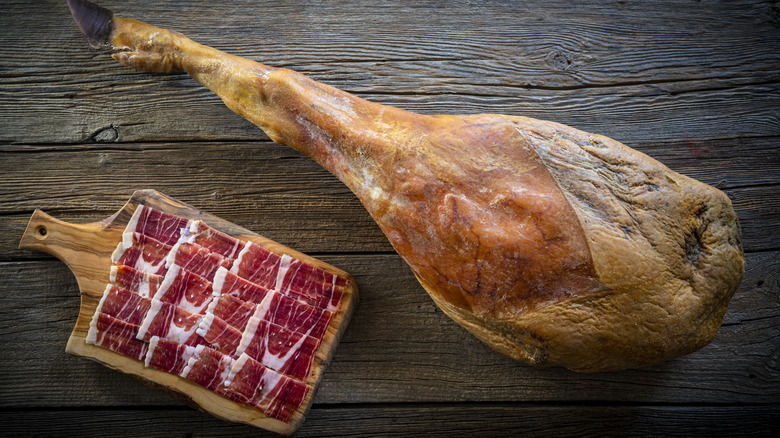Here's How To Determine When Your Meat Has Finished Curing
An aged-old practice, dry curing meat ensures that it lasts longer and has more flavor, thanks to the salt and spices used. When combined with cheese, cured meats make for an especially tasty treat. Preserving the protein involves dehydrating it with salt over a period of time. But how exactly do you know when your cured meat has sat for long enough? You don't want to remove your cured meats from the aging process too soon or leave them for too long either.
Fortunately, there's a fairly simple way to determine if your meat has dry-cured enough. All you need is a scale to measure it before starting the process, then chart its weight as you cure it. Since you're dehydrating the meat, it will lose moisture and therefore weight over time. You will know that your meat has finished curing when it has lost anywhere between 35 and 40% of its weight. If you're trying to figure out what this end goal should be then take your beginning weight and multiply it by 0.65. So if you were curing a 30-pound ham then it would weigh about 19.5 pounds when it's finished curing. That's a tell-tale sign that your cured ham is now ready.
How long it takes meat to cure
The amount of time needed for curing ultimately depends on the cut of meat and the desired effect. Depending on what you're after, it can take anywhere from a few days to a few weeks to even a few months. You should ask yourself if you're planning on consuming the meat soon or preserving it for a later date. For instance, you would only need a few weeks to properly preserve a small duck breast to last a while. However, if you're looking for a quick way to add a dose of flavor to your bird before smoking, then you can cure a chicken or other fowl in a matter of days using a brine solution. This is considered a milder cure.
Meanwhile, pork cuts particularly cured ham can be longer-term investments requiring much more time to properly cure. Ham roasts can take several months. Hams should be wet-cured for one day for every two pounds. The type of curing plays a crucial role as well. Wet-cured meats involved submerging the meats in a saltwater brine. As such, it won't lose its mass in the same way as when dry-curing is used. The latter approach involves covering the meat in salt and allowing it to dehydrate over a longer period of time.
Avoid these mistakes when curing meats
When it comes to curing meats, it's important to consider the temperature and humidity. To properly cure, you want to create a stable environment with a low temperature throughout. Low temperatures in the 30 degrees Fahrenheit range will help prevent the food from spoiling during the curing process. It will also promote the salt to take effect and reach the inner depths of your meat.
When it comes to dry curing, you want to be careful not to remove your meat too early. Be sure to use the formula above. If you remove the meat from curing too early, the salt hasn't reached the inner core, which will effectively be ruinous. You should also be sure that you keep quality in mind. If you're not confident in your ability to pick out good bargain-bin meat, you can go to your local butcher for premium cuts or advice on cheaper ones. Also, if you are strapped for time, then you should consider curing a smaller cut of meat as it will take less time to finish. Finally, consider your end goal when deciding the best curing methods. Are you looking for a product to eat much later or a piece of meat to consume for dinner later in the week?


